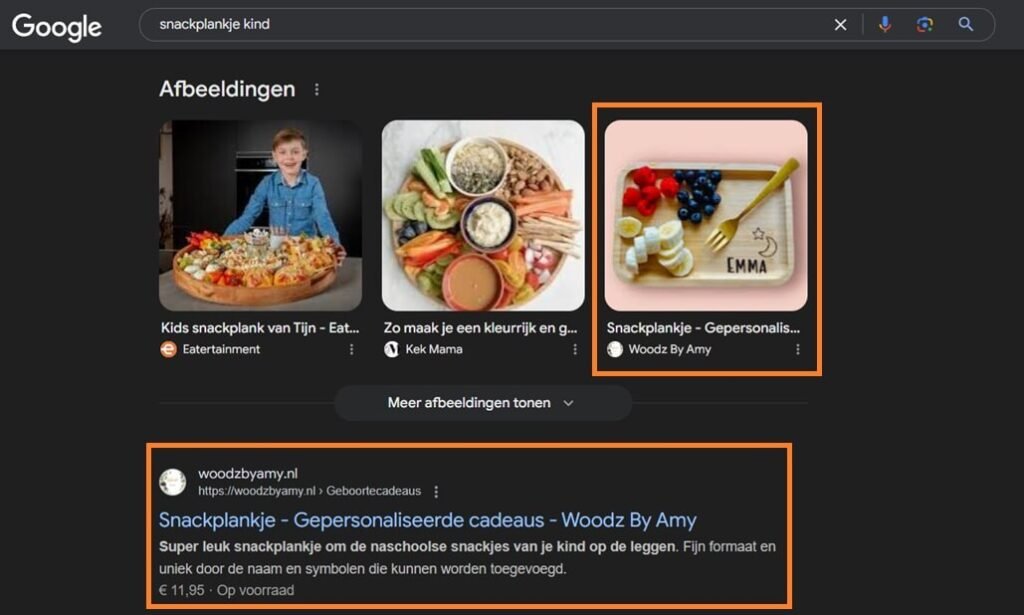The purpose of a landing page is to attract as many visitors as possible and encourage them to take action. In this article, we will take a closer look at landing pages. What are they? And how can we optimise them?
In this article:
What is a landing page?
The name Landing page says it all. This is the page where the visitor "lands"after clicking on a search result or advertisement.
Imagine: you search Google for a nice gift, such as a snack tray for a child. Google shows you the most relevant results. In this case, one of our valued customers.

This specific product page for the snack tray now serves as a landing page (you can find it here). The link in this search result does not refer to the home page, but to the shop page.
Difference between a landing page and homepage
Landingpages are sometimes confused with homepages. This is not entirely unjustified: visitors can arrive on your website through both pages. The main difference is the purpose of the page,
Homepage
A homepage provides information about the various services or products on offer. A good homepage encourages visitors to view other page, such as a specific product/service page, an about me/us page, and a blog page.
Landing page
A landing page has a very specific purpose: conversion.
A landing page is optimised for one specific service or product. The ultimate goal of a landing page is to encourage action. Examples include:
- Get in contact
- Request a quote
- Subscribe to a newsletter
- Buy a product, service or course
A landing page is entirely focused on this goal, with as few distractions to other pages as possible.
Landing pages are often used in paid advertising campaigns, such as Google and social media. You want to recoup your investment in these campaigns at least. This means that a strong and well-structured landing page is essential to get the most out of these campaigns.
Features of a strong landing page
A strong landing page doesn't just come falling down from the skies. These pages are often well-thought-out. Consider the following points when you start creating your landing page.
1. Clear title
The first two seconds are crucial for a page. Two seconds is the time we take to decide whether we stay or leave. It is important to choose a title that is clear, consise and chatchy. What problem can your product/service solve?
2. Catchy intro
The title is followed by a powerful introduction. Keep this short and concise. Try to trigger the visitor as much as possible with benefits of your product/service, unique selling points and powerful terms. The visitor should get the idea (or feeling) that your page/product/service is what he/she is looking for.
Emphasise the advantages of your offer and the problems it solves. End with a clear call-to-action, such as a button.
3. Visual elements
Short assignment: try not to think about an airplane for the next 3 seconds.
Did you succeed? No? Did you still picture the airplane? We did too.
People are visually oriented, which means that photos and videos can have high value. They can support your written text and reinforce their message. They also create a more reliable image. Think, for example, of a professional photo of yourself, a previous project, or a satisfied customer with one of your products.
4. Call to Action (CTA)
We briefly touched this in point 2. However, a CTA deserves its own point.
A CTA is a button that encourages action, for example 'get information for free'. Make sure this button is clearly visible. You can make it stand out by using a striking color and catchy text that encourages people to click on it('sign up and receive the first 3 months for free!'). You can use a CTA more than once on your landing page. However, be careful not to use it too often as this can come across as pushy.
5. Social evidence
Ensure that your landing page conveys trustworthiness. Fortunately, you do not have to do this alone. You can leave this to your previous satisfied customers. Consider the following options:
- Written reviews on your website
- Written reviews on platforms such as Google or Trustpilot
- Quotes
- Logos of your customers' companies

6. Fast and optimised for all devices
Fast loading times are crucial for your landing page. This applies to your entire website, too. Make sure that your website, and especially your landing pages, is optimized for all devices, such as desktops, tablets and smartphones. This will not only help you score higher in Google, but it's also beneficial for your visitors.
In conclusion
A good landing page can make the difference between a visitor leaving your webpage immediately and a visitor becoming a customer. Make sure your landing pages are clear, convincing, reliable and goal driven.
You can defenitely do it!
No time for making a website or landing page? Outsoure it!
As a freelancer, you probably have enough on your plate. You want to help your customers, grow your business and offer your services. Perhaps we can help you!
At Mansvelt Online, I help you create a professional and converting website with landing pages with one simple goal: achieve results.
Please contact me and perhaps we'll talk soon!